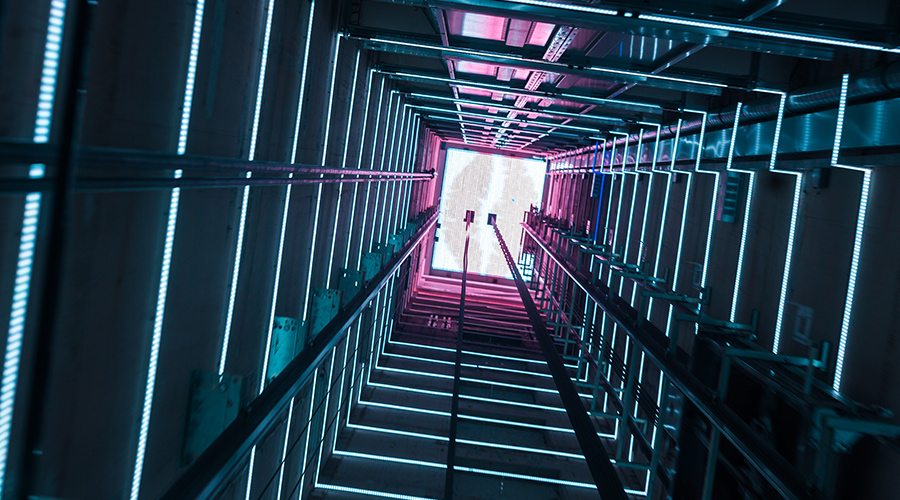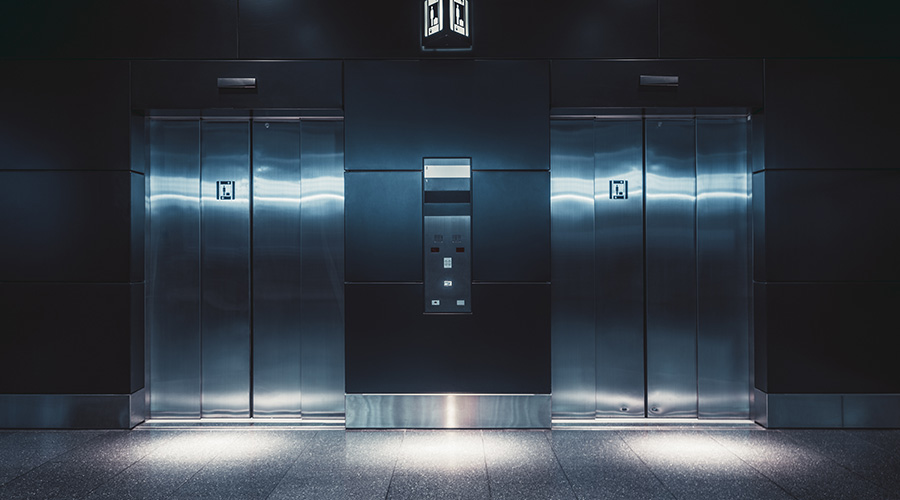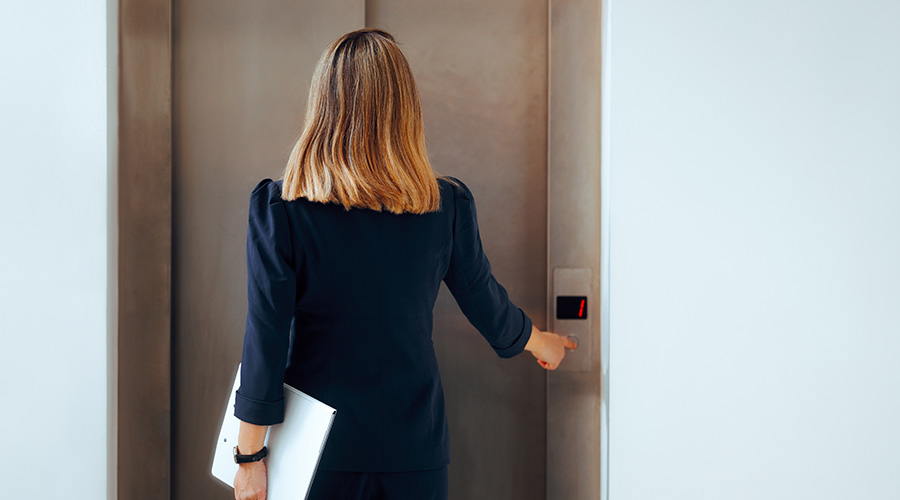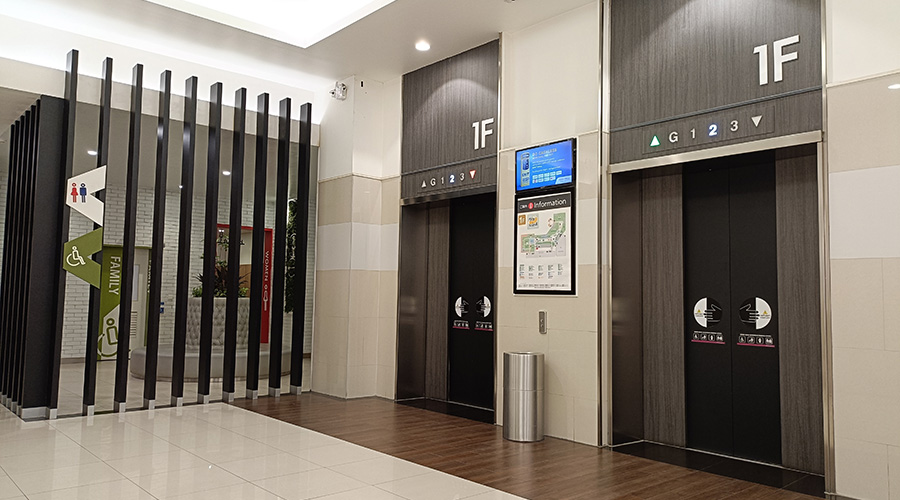Elevators
Faster, smarter, safer
The maxim, “What goes up, must come down,” doesn’t always seem true for those waiting in a building lobby for an elevator. Seconds seemingly turn into minutes as building occupants fiddle with wristwatch bands, fold their arms across their chests and stare at the floor waiting for the elevator to take them to their offices.
Waiting is one of the often-heard complaints about elevators. New elevator designs, however, are trying to eliminate those concerns. They are part of a new generation of technology that can improve performance, take up less space in a building and consume less energy.
Called destination elevators, the systems group passengers going to nearby floors, boosting elevator efficiency. Rather than pushing a button with an up or down arrow before entering the elevator, an individual indicates the floor to which he or she is headed. “You almost get the equivalent of the car push controls on the outside of the elevator bank,” says Dennis DeVos, vice president of business development with elevator manufacturer Fujitec North America, Lebanon, Ohio.
A control panel then directs people to the car that will take them to their destination floor most quickly. The elevator system’s intelligence groups people going to floors in close proximity, limiting unnecessary stops. John Chapman, director of product management with Schindler Elevator Corp., Morristown, N.J., says the way users recall the destination elevator is like taking a taxi; a conventional elevator is like riding a bus.
Of course, there’s the risk that some individuals either won’t understand the system or will try to thwart it. To remedy that, some destination elevators eliminate the destination buttons inside the cars but retain emergency call buttons. Or the system may disable the interior buttons until the car has left the floor; at that point, an individual who punched in the wrong number would be allowed to enter another floor number.
Another innovation in elevator technology is the introduction of machine-room-less (MRL) elevator systems. The absence of a machine room frees up space that can be rented or used for other purposes. If a building is subject to height restrictions, an MRL elevator might allow the structure to meet the restriction by reducing the height needed for a new building.
What’s more, MRL systems allow greater flexibility in locating the elevators. “You can put an elevator anywhere in a building, without structural considerations,” says DeVos. “You just cut a hole.”
MRL elevators use permanent magnets to boost the power of the motor. This reduces the size of the motor so that it’s small enough to fit within the elevator hoistway rather than requiring a separate machine room. For instance, the EcoDisk MRL elevator from KONE uses an 8.7 horsepower motor to do the same work that a 22.7 horsepower traction machine or 40 horsepower hydraulic motor could do, says Russ Mitchell, marketing manager for new equipment business with the KONE, manufacturers of the EcoDisk MRL elevator. And, because they use magnets rather than oil to power the elevator car up and down, MRL elevators eliminate the risk of contaminating ground water.
Smaller motors also require less energy. For instance, KONE’s Monospace requires 40 percent less power than a geared elevator and 60 percent less power than a hydraulic unit, according to the company. In addition, because there aren’t as many parts to wear out, the machines are expected to last for 50 to 75 years, Mitchell says.
Brainier Elevators
The controls behind many elevator systems also are improving, cutting wait times for building tenants, says Tom Hubbell, assistant vice president of marketing with KONE. “We’re using artificial intelligence, fuzzy logic and destination control to optimize the use of elevators.”
One system in Australia, for example, is “learning” the typical traffic patterns of building tenants. It tracks daily use and then adjusts its deployment of elevators based on a rolling monthly average. If it becomes apparent that the tenants on floors 10 through 14 typically head to lunch at 12:30 p.m., the control system will provide elevators to those floors at that time.
Advances in computer technology also are allowing engineers’ and technicians to better monitor elevator banks from remote locations. “Current computer technology allows you to do it efficiently and effectively,” says DeVos.
For instance, in addition to diagnosing the reasons a particular elevator has malfunctioned, Fujitec’s Vision software creates a history detailing each elevator’s operation, such as the level of machine vibration. “These are things you might not pay attention to on a service visit,” says DeVos. “Now, you can create a history, which might allow you to see how problems arose.”
Schindler’s remote-monitoring software diagnoses system problems and dispatches technicians to trouble spots. Before heading to a unit in trouble, a hand-held computing device will inform the technician which elevator to examine and what problems to check. Once the work is complete, the technician enters the solution into the system. “That way, the system is continually learning,” says Schindler’s John Chatman, director of product management.
Security and Reliability
The growing concerns about security apply to elevator operations as well as other entry and exit points of buildings. For instance, it’s important to know that only individuals with approved security clearances are able to reach certain floors, says DeVos.
To accommodate that need, today’s elevator control software can be programmed to prohibit access to certain floors unless the individual entering has the required identification device.
In addition, the widespread blackout in August prompted facility executives to focus on the ability of elevator systems to work when the power goes out, says Ken Segel, vice president of marketing with Schindler.
Schindler offers a suite of products to address this need. One is an elevator control panel with a hands-free emergency phone and an emergency lighting system that comes on if the regular power system should go out.
Another product automatically moves a hydraulic elevator car to an exit floor in the event of a blackout. “It uses gravity to go down,” says Fred Essenwein, manager of the upgrade product line with Schindler. “It would let the car descend and open to let people exit.”
All of these innovations in elevator technology promise to improve the ability of people to move within a building, better meeting the needs of both building occupants and facility executives. “Facility executives are focusing on issues of reliability, safety, information and communication, ecology and conservation, and value,” says Segel.
Karen Kroll, a contributing editor to Building Operating Management, is a freelance writer who has more than 10 years of experience covering real estate and facility issues.
Bigger and Better Escalators
Improvements in vertical transportation aren’t limited to elevators. Technology also is improving the operation of escalators. Modular parts make repairs less disruptive and expensive. Newer and bigger machines better handle continuous high-volume traffic. In addition, designs are being implemented to improve safety.
KONE, for instance, has introduced an escalator modernization package that uses modular components to modernize existing systems. The package enables facility executives to avoid the disruption of conventional escalator replacement. For the most part, installation work goes on inside the existing truss so that facilities continue to operate as usual while work is under way.
“While the core technology is identical to our new escalator product, the ECOMOD system is custom-engineered to fit the particular truss of the escalator being modernized,” says Jim Turner, vice president with KONE.
Escalators also are getting bigger and beefier, so they’re better able to handle large crowds in places like stadiums and arenas. Fujitec, for instance, has introduced new escalators in several stadiums. The company’s design is based on the escalators used in subways and train stations. “They’re beasts, and intended to operate under heavy traffic conditions,” says Dennis DeVos, vice president of business development.
Finally, improvements in escalator design enhance safety. One example: In addition to reducing the gap between the steps and skirt, Schindler has added a brush that runs the length of the skirt. This alerts a passenger that a foot is nearing the seam joining the step and skirt. Upon feeling the brush, most passengers will move their feet away, reducing the risk that they’ll get caught.
Related Topics:











